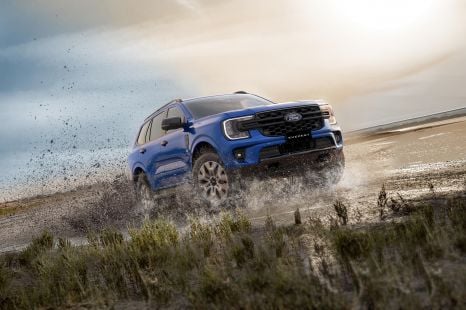

Damion Smy
Ford Everest Tremor gets 260kW V6 ‘Ranger Raptor’ treatment
5 Days Ago
When the redesigned new Ford Everest arrives later in 2022 it will offer more technology, capability, a new turbo-diesel V6, and a new Platinum flagship.
It continues to be the SUV counterpart to the Ranger, which means it’s based on the redesigned ute due here mid-year and therefore uses a heavily updated version of the existing T6 platform.
Pricing and specific launch timing have yet to be released, though the Everest will be launched after the Ranger. We expect a launch sometime in the third quarter of 2022.
Retail Price
Transmission
10-speed auto
Driven Wheels
4x4 or Rear
Fuel Type
Diesel
Body Types
SUV
Powertrain Type
Combustion
View 52 images
Retail Price
Transmission
10-speed auto
Driven Wheels
4x4 or Rear
Fuel Type
Diesel
Body Types
SUV
Powertrain Type
Combustion
No Expert reviews
Check back soon for our take
CarExpert does the hard work to get you the best price. No negotiating, no hidden costs, just expert help and real savings on your next new car.
Engine specs, power, and efficiency
Drive Feel: Steering, Suspension, Ride Quality
Strength, stability, and off-road performance
Design, size, and presence on the road
Comfort, tech, and convenience inside
Infotainment, connectivity, and smart features
Protection, prevention, and alerts
Coverage, maintenance, and peace of mind
The Ford Everest comes in a variety of variants with the cheapest being Ambiente and the most expensive being Platinum.
Quickly see how the Ford Everest stacks up against its competition.
Select any benchmark to see more details.
Where expert car reviews meet expert car buying – CarExpert gives you trusted advice, personalised service and real savings on your next new car.
| Specification | Measurement |
|---|---|
| Overall Length | 4,914 mm |
| Overall Width | 1,923 mm |
| Overall Width (Inc Mirror) | 2,207 mm |
| Overall Height | 1,842 mm |
| Wheelbase | 2,900 mm |
| Turning Circle | 11,800 mm |
| Load Capacity | 741 mm |
Dimensions in this table show the minimum and maximum values of all variants for this vehicle.
Our Ford Everest Exterior and Dimensions Page has every measurement you need to know exactly how this vehicle will fit your driving, garage, or work needs.





Ford Everest


Damion Smy
5 Days Ago


Damion Smy
1 Month Ago
Where expert car reviews meet expert car buying – CarExpert gives you trusted advice, personalised service and real savings on your next new car.
Ford Everest
The cheapest Ford Everest is the Ambiente that starts from $52,990.
See all Ford Everest PricingThe most expensive Ford Everest is the Platinum that starts from $76,881.
See all Ford Everest PricingThe best towing capacity of a Ford Everest is 3500 kg offered by the following variants: Ambiente, Trend, Sport and Platinum.
See all Ford Everest towing capacityThe largest Ford Everest is the Ambiente which measures 1923mm wide, 4914mm in length and sits 1842mm tall.
The most powerful Ford Everest is the Sport which has 184kW of power from its 3.0L Turbo Diesel Common Rail engine.
The Ford Everest is built in Thailand and shipped to Australia.
The heaviest Ford Everest is the Sport which weighs 3150 kg (kerb weight).
The Ford Everest uses Diesel.
# Based on VFACTS and EVC data
* Average savings based on recent CarExpert customer transactions. Actual savings will vary depending on vehicle make and model, location, stock availability, and other factors.
† Displayed prices exclude on-road costs such as delivery charges, registration fees, number plates, insurance and applicable road taxes. These prices are subject to change without notice and may not reflect current market pricing or dealer offers.
 Automotive Vehicle Spec Data & 4K images Powered by JATO Dynamics Ltd
Automotive Vehicle Spec Data & 4K images Powered by JATO Dynamics Ltd